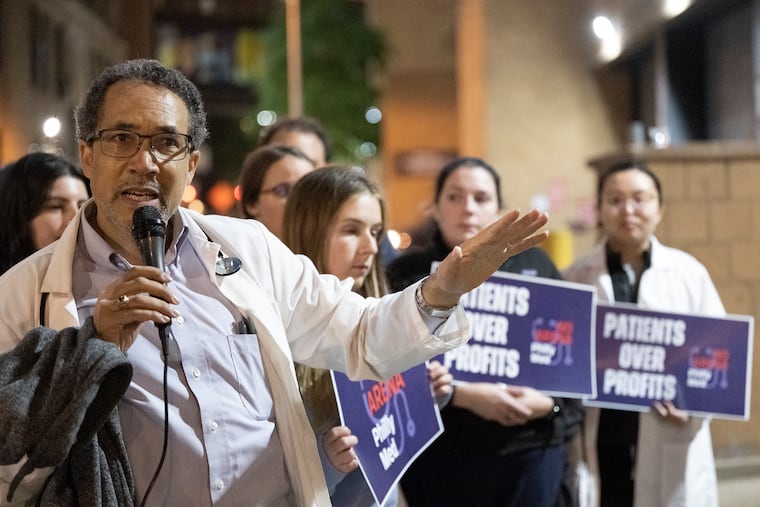Some Philly doctors and nurses come out against proposed downtown Sixers arena
Health-care workers united as “No Arena Philly Med” said game-day traffic could harm patients.

A group of Philadelphia doctors, nurses, and medical technicians spoke against the Sixers’ plans for a downtown arena Tuesday night, contending that game-day traffic could delay people from reaching critical hospital care.
Gathering across the street from a Jefferson Hospital emergency and trauma entrance, health-care workers united as “No Arena Philly Med” said they were “putting patient safety over billionaire profits” and warning that a Center City arena “would harm patient health.”
The arena site at 10th and Market Streets is just north of Jefferson, a Level One trauma center that provides comprehensive care for the most seriously injured and sick patients.
People suffering from heart attacks, gunshot wounds, or traffic injuries go to Jefferson if they live between Girard Avenue and the South Philadelphia sports complex, said William King Jr., a doctor at one of the largest private African American pediatric practices in Philadelphia.
“What they don’t need is a giant parking lot of 5,000 cars that just let out after a Sixers game, and 18,000 people wandering around on Market Street,” he said.
Pennsylvania Hospital, noted for its obstetrics care, is just south of the location, he added.
The team intends to build atop SEPTA’s Jefferson Station, four blocks east of City Hall.
Traffic has been a focus of public concern almost since the day the project was announced in July 2022.
The Sixers say that they have sufficient plans to handle cars, and that they intend to significantly reduce auto use by encouraging fans to take transit to games and events. Helping Philadelphia move toward a greener future, the team says, is a main reason for locating the arena at a major public-transit center.
Efforts to reach Sixers spokespeople were unsuccessful on Tuesday.
A city-sponsored impact study said the Sixers’ goal of increasing transit use to 40% of fans, while another 40% travel by car, is attainable but not a foregone conclusion. Traffic would remain manageable if no more than 40% of attendees drive, but even marginal increases in auto use beyond that threshold would result in gridlock at critical intersections, the study said.
Jefferson officials said issues connected to the arena could be addressed.
“As we have consistently said, Jefferson supports initiatives that strengthen the economic vitality of Market East and its surrounding areas,” executive vice president Nick Ragone, chief of marketing and communications, said Tuesday. “After conducting a thorough evaluation of the proposal, and learning more about Mayor Parker’s vision for this community, we are confident that potential challenges can be effectively mitigated and are significantly outweighed by the benefits of investing in this crucial commercial corridor.”
Jefferson CEO Joseph Cacchione earlier issued a statement that said the arena proposal “prioritizes public safety, addresses the concerns of local residents, and carefully manages traffic considerations to ensure uninterrupted access to critical health-care services, including our Level 1 Trauma Center at Thomas Jefferson University Hospital.”
A transportation study conducted for the team by Philadelphia-based Langan Engineering & Environmental Services Inc. said that, given ease of public transit to Jefferson Station, no new parking would be necessary. It concluded that existing lots and garages were more than sufficient to handle game-day traffic.
A different study undertaken by Hunden Partners at the behest of the Sixers’ Wells Fargo Center landlord, Comcast Spectacor, projected that only about 15% of fans would take public transit, and that traffic gridlock would grip Market Street East before and after events.
Hunden estimated that parking would be needed for about 4,700 cars; the Sixers’ figure was lower, at 3,700, according to their traffic study.
Mayor Cherelle L. Parker endorsed the arena project last month, announcing an agreement with the Sixers that she said would bring big benefits to the city, including new jobs, tax revenue, and business opportunities — and could help spark a revival on Market Street East.
City Council is expected to receive arena-enabling legislation on Oct. 24, and a vote could come by the end of the year.
“I understand the desire to get more entertainment and business in the city,” said Raymond Palidora, an oncology researcher. “I understand the desire for the Sixers organization to build a new arena. Just don’t build it here.”
Emergency-room technician Jimmy Low said he was both worried and angry about the prospect of a downtown arena, including concern that seriously ill patients could be delayed in situations where every minute counts.
“I don’t want my death certificate to say I’m dying of cardiac arrest because of arena traffic,” he said. “This is very scary.”